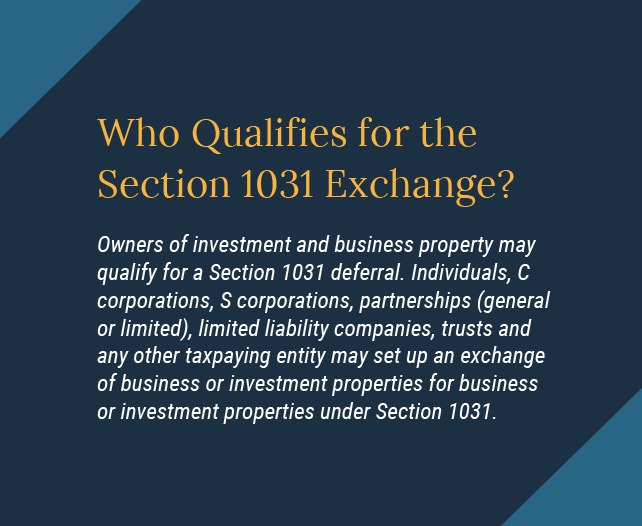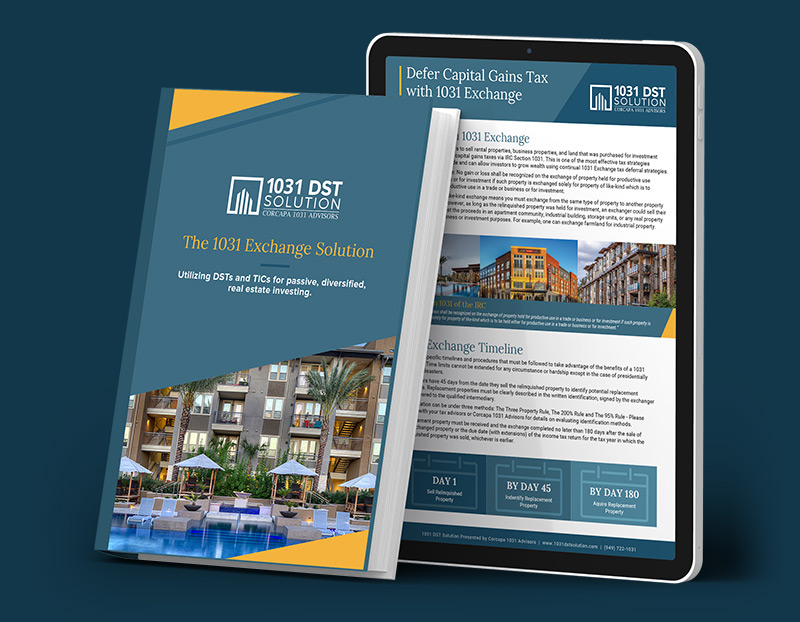Texas 1031 Exchange Rules for Real Estate Investors
1031 Exchange Rules in Texas
2024 Texas 1031 Exchange Guide
Interested in learning more 1031 exchange rules in Texas? This guide will provide you an overview of the 1031 Exchange process, the benefits of a 1031 Exchange and common questions people ask when Texas investors are considering a 1031 Exchange.
The IRS allows Texas investors to sell rental properties, business properties, and land that was purchased for investment purposes and defer all capital gains taxes via IRC Section 1031. This is one of the most effective tax strategies available in the tax code and can allow investors to grow wealth using continual 1031 Exchange tax deferral strategies.
IRC 1031 is defined as: No gain or loss shall be recognized on the exchange of property held for productive use in a trade or business or for investment if such property is exchanged solely for property of like-kind which is to be held either for productive use in a trade or business or for investment.
Many assume that like-kind exchange means you must exchange from the same type of property to another property of the same type. However, as long as the relinquished property was held for investment, an exchanger could sell their property and reinvest the proceeds in an apartment community, industrial building, storage units, or any real property being used for business or investment purposes.

What Is a Like-Kind Exchange?
The property Texas investors sell and the replacement property they purchase must meet certain requirements to qualify for a 1031 Exchange. Both properties must be held for use in a trade or business or for investment. Both properties must be similar enough to qualify as “Like-Kind.”
Property types that are considered to be “Like-Kind” properties and are eligible for 1031 Exchange in Texas are:
- Multifamily Apartments
- Healthcare
- Self Storage Facilities
- Retail Centers
- Industrial Warehouses
- Student Housing
- Oil and Gas
- Agriculture/Farmland
Any Texas real estate held for productive use in a trade or business or for investment purposes is considered like-kind. A primary residence would not fall into this category, however, vacation homes or rental properties may qualify.
What Property Types Qualify for a Texas 1031 Exchange?
Land, land improvements resulting from human effort including buildings and machinery sited on land and various property rights over the preceding (ex. homes, apartment buildings, shopping centers, commercial buildings, factories, condominiums, leases of 30-years or more, quarries and oil fields) qualify. All types of real property are considered like-kind and thus exchangeable for all other types of real property in a 1031 exchange.
Commercial
Investors can 1031 exchange into commercial properties such as industrial and manufacturing facilities like a self-storage facility, distribution facility, retail shopping center, or office building.
Residential
Investors can 1031 exchange into residential multifamily properties such as 300-unit class A luxury multifamily facilities, 55+ active living communities, or student housing properties.
Farmland & Agriculture
Investors can 1031 exchange from farmland into residential multifamily properties or the reverse, where farm owners can sell farmland and reinvest proceeds into residential multifamily communities.
Delaware Statutory Trust (DST)
Investors can 1031 exchange from traditional property into DSTs of any type of asset class such as multifamily or self-storage.
Tenants-in-Common (TIC)
Investors can 1031 exchange into TIC ownership of properties in a variety of asset classes such as self-storage, Amazon or Costco tenanted industrial facilities, or even senior care facilities.
Oil and Gas
Investors can 1031 exchange from traditional property into oil and gas investments as working interests or royalty interests. We have had clients sell inherited royalty interest owned for decades and reinvest in income-producing multifamily properties.
1031 Exchange Qualifications in Texas
Owners of investment and business property may qualify for a Section 1031 deferral. Individuals, C corporations, S corporations, partnerships (general or limited), limited liability companies, trusts and any other taxpaying entity may set up an exchange of business or investment properties for business or investment properties under Section 1031.

The 1031 Exchange Solution E-Book
Utilizing DSTs and TICs for passive, diversified, real estate investing.
Download our FREE 1031 Exchange E-book that provides valuable information on tax-deferred exchanges, 1031 Exchange guidelines and a step-by-step guide on how the 1031 Exchange process works.
The 1031 Exchange Solution E-Book
Utilizing DSTs and TICs for passive, diversified, real estate investing.
Download our FREE 1031 Exchange E-book that provides valuable information on tax-deferred exchanges, 1031 Exchange guidelines and a step-by-step guide on how the 1031 Exchange process works.
Types of 1031 Exchange Structures in Texas
Simultaneous Swap
To accomplish a Section 1031 exchange, there must be an exchange of properties. The simplest type of Section 1031 exchange is a simultaneous swap of one property for another.
Deferred Exchanges
Deferred exchanges are more complex but allow flexibility. They allow you to dispose of property and subsequently acquire one or more other like-kind replacement properties.
To qualify as a Section 1031 exchange, a deferred exchange must be distinguished from the case of a taxpayer simply selling one property and using the proceeds to purchase another property (which is a taxable transaction). Rather, in a deferred exchange, the disposition of the relinquished property and acquisition of the replacement property must be mutually dependent parts of an integrated transaction constituting an exchange of property. Taxpayers engaging in deferred exchanges generally use exchange facilitators under exchange agreements pursuant to rules provided in the Income Tax Regulations.
Reverse Exchange
A reverse exchange is somewhat more complex than a deferred exchange. It involves the acquisition of replacement property through an exchange accommodation titleholder, with whom it is parked for no more than 180 days. During this parking period the taxpayer disposes of its relinquished property to close the exchange.

What are the Texas 1031 Exchange Time Limits?

While a like-kind exchange does not have to be a simultaneous swap of properties, you must meet two time limits or the entire gain will be taxable. These limits cannot be extended for any circumstance or hardship except in the case of presidentially declared disasters.
The first limit is that you have 45 days from the date you sell the relinquished property to identify potential replacement properties. The identification must be in writing, signed by you and delivered to a person involved in the exchange like the seller of the replacement property or the qualified intermediary. However, notice to your attorney, real estate agent, accountant or similar persons acting as your agent is not sufficient.
Replacement properties must be clearly described in the written identification. In the case of real estate, this means a legal description, street address or distinguishable name. Follow the IRS guidelines for the maximum number and value of properties that can be identified.
The second limit is that the replacement property must be received and the exchange completed no later than 180 days after the sale of the exchanged property or the due date (with extensions) of the income tax return for the tax year in which the relinquished property was sold, whichever is earlier. The replacement property received must be substantially the same as property identified within the 45-day limit described above.
Steps to Complete a Texas 1031 Exchange
1. CONSULT
Speak with your tax and financial advisors before selling your property to make sure a 1031 exchange is right for you.
2. FIND A QUALIFIED INTERMEDIARY (QI)
Choose a QI before you close escrow. They will hold your exchange proceeds during the transaction process.
Do not take receipt of funds – all proceeds must go to the QI or 1031 is invalidated.
3. CHOOSE REPLACEMENT PROPERTY
You have 45 days to “identify” replacement property, and 180 days to close on the relinquished property.
1031 DST Solution presented by Corcapa 1031 Advisors specializes in locating like-kind replacement property at equal or greater value for full tax-deferral.
4. DEBT OR NO DEBT?
The IRS requires matching the debt from your relinquished property with equal or greater debt in the replacement property.
Don’t need debt? You can buy properties with debt or without.
Debt always brings some risk to real estate ownership, but can provide the benefit of increasing depreciable basis and sheltering some cash flow from taxation.
5. PROCESSING & PAYMENT
After you select your replacement property, Corcapa prepares your purchase documents and sends them to you for signature.
Next, sign paperwork with your QI releasing your sale proceeds to the DST escrow account.
6. RECEIVE DISTRIBUTION
After you’ve closed on the replacement property, cash flow distributions are typically made monthly and deposited directly into your bank account.
Potential Benefits of a Texas 1031 Exchange
- Diversification
- Lower Minimum Investments
- No Individual Annual LLC Filings
- Potentially Greater Cash Flow
- Lower Risk
- Financing Access
- Non-Recourse Loans
- Larger Property Access

1031 Exchange FAQs
Learn more about the 1031 Exchange process and common questions about 1031 Exchanges.
How do I complete a 1031 Exchange?
To accomplish a full tax deferral on the sale of rental property you must follow the IRS Section 1031 Guidelines. Corcapa 1031 Advisors recommends the following:
- Be in communication with your Corcapa 1031 Advisors representative well ahead of your proposed relinquished property sale closing date so we can begin to research and identify potential replacement property.
- Be sure to select and assign a Qualified Intermediary “QI” or Accommodator to receive the sale proceeds from escrow. Corcapa can recommend QIs for you. Be sure to research the financial backing of QIs before selecting them. Be especially careful to NOT take personal receipt of the funds or your exchange will be invalidated.
- From the day you close your relinquished property, you will have 45 days to identify your replacement property(ies). This identification must be in writing, and can follow one of three possible identification rules:
- 3-property rule: Up to three properties are identified no matter what their value.
- 200 percent rule: Any number of properties is identified as long as their combined fair market value (FMV) does not exceed 200% of the FMV of the relinquished properties.
- 95 percent rule: Any number of properties are identified no matter what the aggregate FMV, provided 95% of the value of the identified properties is acquired.
- The investor must close on the identified replacement property(s) within 180 days from the close date of the relinquished property. This is an additional 135 days from the end of the 45 day period in which to close on your replacement property(ies).
- Additionally, for full tax deferral you must purchase equal or greater purchase price, equal or greater debt and reinvest all cash.
- Please review the IRS publication here for further details: http://www.irs.gov/uac/Like-Kind-Exchanges-Under-IRC-Code-Section-1031
What is a DST?
A DST is an acronym for a Delaware Statutory Trust which is fractional ownership of real estate. In 2004 the IRS issued a Revenue Ruling clarifying the terms on structuring a DST investment for 1031 purposes. Please review the IRS Revenue Ruling 2004-86
Will a DST or TIC Qualify for a 1031 Exchange?
The Revenue Ruling 2004-86 issued by the IRS governs how the DST should be structured so that the real estate program is likely to fit within the guidelines of a 1031 exchange. TICs have a Revenue Procedure 2002-22 that discusses the 15 structure points TIC programs should have in order to receive a “should level” tax opinion. Corcapa works with sponsors of DST and TIC offerings who structure the offerings with a legal opinion from experienced industry attorneys for 1031 exchange purchases. We recommend that you discuss this with your tax and legal advisors and we will provide all documentation to these advisors to use in analyzing your replacement property options.
Why do investors Choose DSTs or TICs for 1031 Exchange Property?
The most common reasons that investors select DSTs are:
- Potentially Greater Cash Flow Than They Are Currently Receiving: Most DSTs have between a 4.00% – 5.50% projected cash flow based on the anticipated rental income less expenses. For example, if you invest $1,000,000 of equity into a DST with a 4.5% projected cash flow, this would provide a projected net annual income of $45,000. This could be a higher net cash flow than you are currently receiving on your rental property. As with all real estate the income cannot be guaranteed because the rental income and expenses can increase or decrease unexpectedly.
- Ability to Diversify: You can reinvest your relinquished property sale proceeds into multiple investments in different cities, states, and asset classes such as apartments and net lease retail.
- Non-Recourse Loans: Virtually all the loans within the DSTs that are approved by DAI Securities, LLC are non-recourse which means the investor does not personally guarantee them.
- Easier Financing: Access to financing for investors needing debt on their replacement property
- Passive Ownership Structure: Many investors desire to reduce their active property management as they grow older and DSTs offer passive ownership.
We recommend that all clients review each PPM in detail and consult their tax and legal advisors to full understand the benefits and risks of the investment. Corcapa 1031 Advisors is happy to attend a meeting with your tax and legal advisors or have a conference call to answer all questions.
How quickly can I close escrow on my DST?
This depends on the velocity of the real estate market. Currently there is a significant upswing in 1031 exchange activity and also an upswing in the purchase of DST properties. More attractive DST offerings can sell out quickly so its important to alert you Corcapa representative early on and let them know you have a pending 1031 exchange. This way we can be very proactive in finding the replacement properties that fit you needs.
Most clients prefer to have a closing on their replacement properties sooner so as to begin earning income. Its possible to have a closing on your DST within three to ten business days. Alternatively, clients may prefer to wait a few weeks to close escrow on their replacement property and this can easily be arranged.
One advantage of closing escrow sooner on your DST purchase is that the cash flow begins to accumulate immediately after closing and is paid with the first distribution the following month.
What is the Fee Structure?
Each offering has a detailed Private Placement Memorandum (PPM) to review which clearly explains the fee structure. Every offering is slightly different, but you can review the specific fees which are generally found in the Estimated Use of Proceeds table. You do not pay an outside check or fee to Corcapa upon purchase. Should you choose to buy a DST offering through Corcapa the sponsor pays us a commission based on the equity you invest. Fees are paid by the buyer, so most offerings are marked up approximately 6-10% to cover the expenses of the transaction. Despite these fees, if the projected cash flow is 4.5% on a $1,000,000 equity investment, the annual income is anticipated to be $45,000.
How do you report Section 1031 Like-Kind Exchanges to the IRS?
You must report an exchange to the IRS on Form 8824, Like-Kind Exchanges and file it with your tax return for the year in which the exchange occurred.
Form 8824 asks for:
- Descriptions of the properties exchanged
- Dates that properties were identified and transferred
- Any relationship between the parties to the exchange
- Value of the like-kind and other property received
- Gain or loss on sale of other (non-like-kind) property given up
- Cash received or paid; liabilities relieved or assumed
- Adjusted basis of like-kind property given up; realized gain
If you do not specifically follow the rules for like-kind exchanges, you may be held liable for taxes, penalties, and interest on your transactions.
Do I still receive traditional real estate depreciation on the income?
Yes, DST ownership is similar to traditional real estate ownership and the year-end tax reporting will detail your share of the depreciation expenses.
When does the cash flow start? How frequently will I be paid?
Projected cash flow begins the very next month after investment. For example, if you close on your DST purchase on August 15th, you will typically receive a distribution on September 15th for all the days you were invested in August. The October distribution would be a full month distribution for all of September and so forth. Investors can elect to receive the distributions via direct deposit or a mailed check, although almost all investors choose direct deposit. A projected cash flow of a 1031 property is not a certain or guaranteed payment and payment is not assured.
Are you an Accommodator?
While Corcapa is happy to refer you to accommodators, we cannot provide accommodator/Qualified Intermediary services. We specialize in the replacement properties for our clients’ 1031 exchanges.
What is Corcapa? What is DAI Securities, LLC?
Corcapa 1031 Advisors is a Finra www.finra.org registered branch office located in Costa Mesa, CA. Securities offered through DAI Securities, LLC, member FINRA/SIPC.
* All information provided on this page is time sensitive and subject to change
Finding the Right Texas 1031 Exchange Advisor
1031 DST Solution presented by Corcapa 1031 Advisors are 1031 exchange and alternative investment specialists helping investors diversify their portfolio with alternative real estate investments and 1031 Exchange Replacement Property. We exclusively focus on investments for 1031 tax-deferred exchanges.
Our qualified Texas 1031 advisors help real estate investors diversify their financial goals through alternative real estate investments in the form of like-kind replacement properties that meet their investment requirements, defer taxes and grow wealth.
Qualified Texas 1031 Advisor
President of Corcapa 1031 Advisors, Christina Nielson, has over two decades of experience specializing in 1031 Exchange Replacement Property and tax-deferred 1031 exchanges in Texas.
Christina works closely with Texas investors to find solutions which meet their investment objectives. She has helped investors purchase an approximate total of $100 million of securitized real estate and is a consistent top producer for her broker dealer.

“I have personally completed over 400 fractional real estate transactions in excess of $400,000,000 in my 20 year career – making our firm one of the premier 1031 exchange into DSTs and TICs firms in the United States. We have clients in 27 states.”
– Christina Nielson, Corcapa 1031 Advisors President
Your Local Texas 1031 Exchange Specialist
1031 DST Solution Presented by Corcapa 1031 Advisors
Elm Street & Stone Place
Dallas, TX 75201
*Call for meeting location
Phone: (949) 722-1031
Fax: (714) 594-5830
Email: [email protected]
Texas 1031 Exchange Replacement Property Listings
Browse replacement property offerings for your 1031 exchange.

Register
Prospective clients can register to receive current 1031 Exchange property listings.

Browse Properties
Once approved, you can login anytime and view current 1031 investment properties.

1031 Advisor Guidance
Our team will provide guidance and recommendations based on your investment goals.








